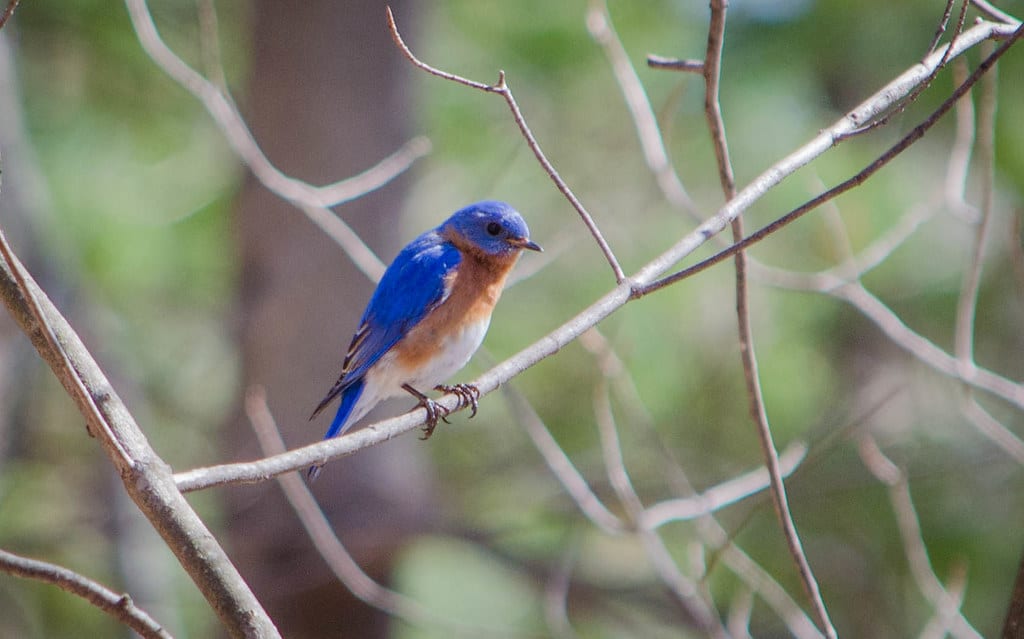
It seems that every year, more and more people want to attract bluebirds to their yard. This makes sense, since bluebirds are some of the most beautiful and attractive backyard songbirds in North America. I’ve been an avid bluebird landlord for almost 20 years, so I’ve got a few suggestions for you if you are new to attracting bluebirds. In this article, I’ll give you my top 11 tips for how to attract bluebirds to your yard in 2023.
Photo above by ashokboghani is licensed under CC BY-NC 2.0
Here are my 11 tips for how to attract bluebirds to your backyard:
- Create an Open Space for Bluebirds
- Put Up a Bluebird House (Nest Box)
- Add Some Low Perches to Your Yard
- Keep Crawling Predators at Bay
- Deter Non-Native Birds
- Put Up a Bluebird Feeder
- Install a Bird Bath
- Grow Plants that Attract Bluebirds
- Plant Trees that Attract Bluebirds
- Consider Keeping a Few Dead Trees
- Monitor Your Bluebird House Weekly
In the rest of this article, I’ll explore each of these tips in depth, so that you know exactly what you need to do in order to attract bluebirds to your yard.
1. Create an Open Space for Bluebirds
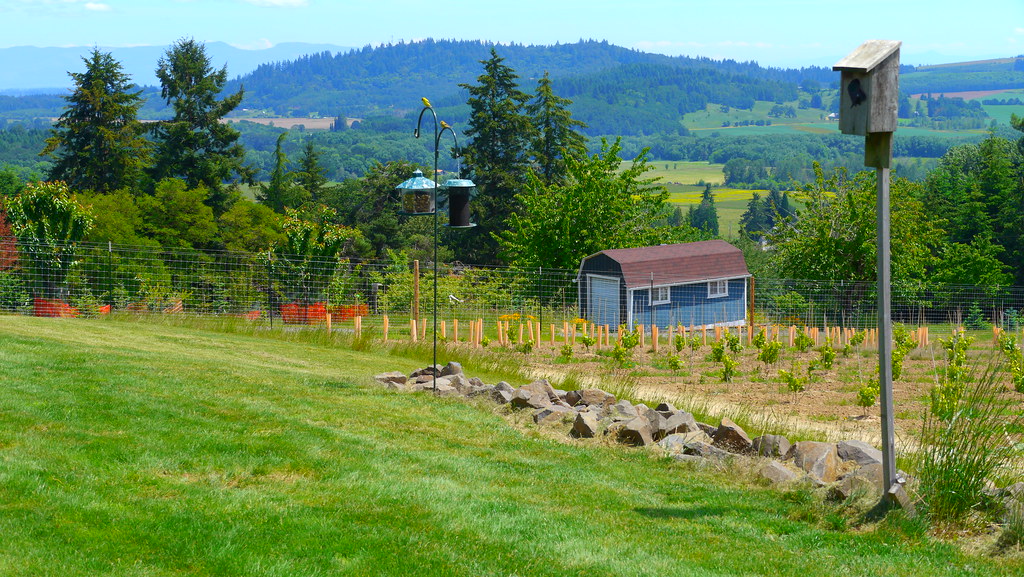
The first thing you need to know about bluebirds is that they thrive in open spaces. Bluebirds hunt insects that they spot on the ground, like grasshoppers, crickets, spiders, and caterpillars. So, they are usually attracted to areas where they can easily find their prey, like fields, lawns, and open grassland.
If you want to attract bluebirds to your yard, try to create an open, inviting environment in your yard that bluebirds will find attractive. Keep your lawn uncluttered and mowed regularly. This will go a long way in providing bluebirds with the ideal hunting space where they can catch insects.
Most larger backyards will naturally be open and very appealing to bluebirds, but even smaller backyards can do the trick. As long as your yard is open, uncluttered, and well trimmed, bluebirds will surely find it.
Now, once bluebirds find your yard, you need to give them a reason to stick around and build a nest. That brings us to tip number two.
2. Put Up a Bluebird House (Nest Box)
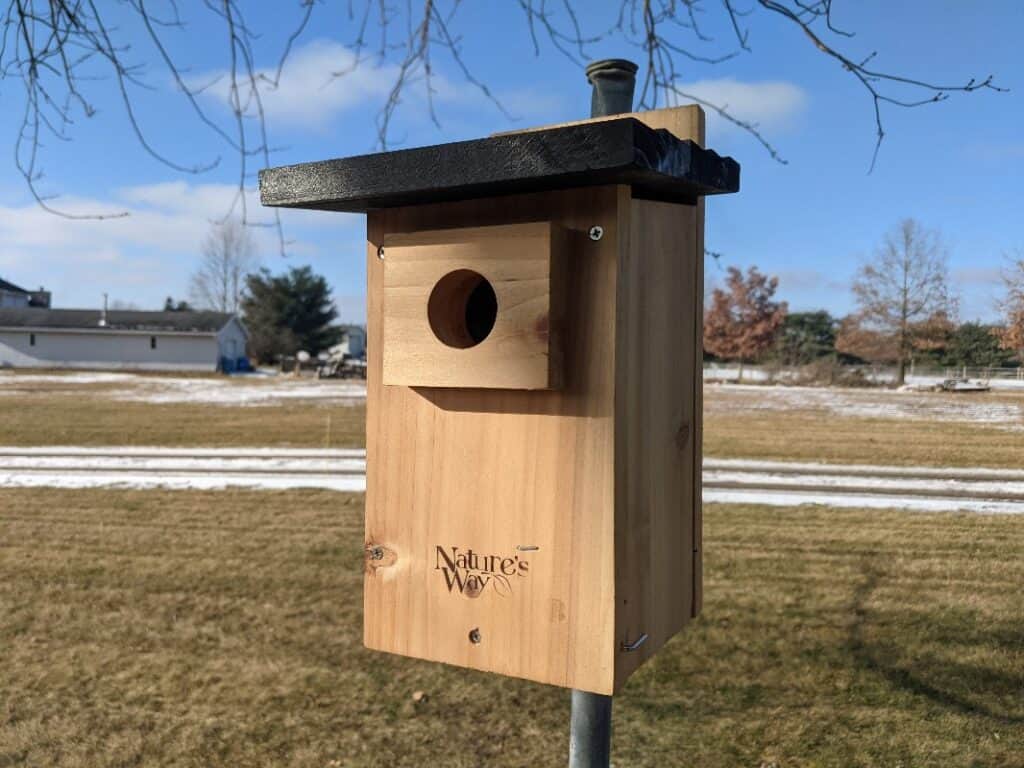
The most important step you can take to attract bluebirds to your yard is putting up a bluebird house, also known as a nest box. Bluebirds are secondary cavity nesters, which means they build their nests inside of holes (or cavities) naturally found in trees. Since natural cavities are hard to come by these days, due to competition from non-native birds, bluebirds readily accept wooden nest boxes as a place to build their nest.
The great thing about putting up a nest box is that you get some level of control on where bluebirds build their nest. Of course, you’ll need to set up your bluebird house in an ideal area in your yard or bluebirds might not use it at all. That’s why I wrote an article all about finding the best location to set up a bluebird house in your yard (click here to read that article for some more helpful information on this topic).
Once you’ve decided to put up a bluebird house, you can either choose to build your own nest box or purchase one from a good retailer. If you’d rather take the easy route and purchase a pre-made nest box (like I usually do), click here to purchase my favorite nest box from Amazon.
If you want to attract bluebirds to your yard THIS YEAR, the best place to start is the Bluebird Landlord Audio Guide. In this audio guide, I’ll tell you everything you need to know about attracting bluebirds in just 59 minutes and 38 seconds.
Check out the Bluebird Landlord Audio Guide here.
3. Add Some Low Perches to Your Yard

Bluebirds mainly catch their prey (insects) by swooping down from the vantage point of a low perch. Because of this, if you have some low perches available throughout your property, your yard will be more attractive to bluebirds.
What kind of low perches do bluebirds like to hunt from?
In general, bluebirds like to perch on the following types of low perches when they are hunting:
- Wooden fence posts
- Chain-link fences
- Tree branches
- The tops of trees and bushes
- Nest box lids
I’ve even seen bluebirds dropping down from telephone wires to catch their prey. While that’s not exactly a low perch, it shows that they have great eyesight. One article in The Wilson Journal of Ornithology claims that bluebirds may be able to spot caterpillars from 50 feet away (source).
But, since we don’t usually have telephone wires spanning the length of our lawns, you’ll usually see bluebirds hunting from lower perches like fence posts and tree branches. If you’ve already got some of these features as a part of your yard’s landscape, you’re in good shape to attract bluebirds.
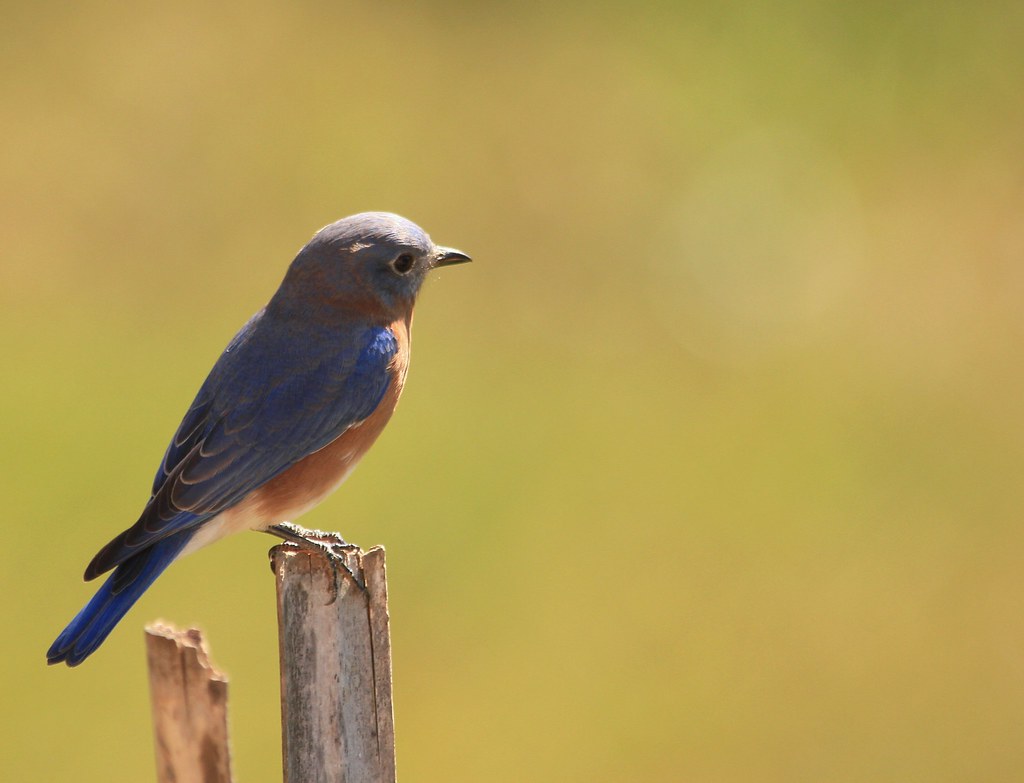
If your yard doesn’t have many naturally low perches like fence posts or trees, don’t worry, you can still attract bluebirds. Just stick a few metal posts or wooden sticks in the ground throughout your yard from the spring to early fall. Bluebirds will find these perches and love them. They are just looking for a convenient vantage point where they can sit and spot their next meal.
Once you’ve set up your nest box in an open area with a few low perches, it’s time to start thinking about keeping bluebirds safe in your yard.
4. Keep Crawling Predators at Bay

During the nesting season, make sure you put the proper precautions in place to protect bluebirds from crawling predators like cats, raccoons, and snakes. These three crawling (and slithering) creatures are the most likely culprits when bluebird eggs or nestlings go missing.
Fortunately, there are a few best practices you can put in place at your nest box to make sure that these animals don’t get to your precious bluebirds.
How to Protect Bluebirds from Common Predators
#1. Mount your nest box on a metal pole instead of a tree or wooden post
Bluebirds don’t care where you mount their nest box – a metal pole, wooden post, or tree is all the same to them – however, crawling predators will have a more difficult time climbing metal poles to get to your bluebird nest box. So, you should mount your nest box on a metal pole for the best results in deterring crawling predators.
#2. Dispose of old nests in a location away from the nest box
When you’re monitoring bluebird nest boxes, occasionally you’ll find a sparrow nest that you’ll need to remove (more on that later) or you’ll need to remove an old bluebird nest. In order to protect bluebirds from crawling predators, make sure you throw away the old nest in a different location away from the nest box. Throwing it on the ground near the nest box can draw predators’ attention to the bluebird house and encourage them to check it out.
#3. Install a stove-pipe style baffle on your nest box pole
If raccoons are a persistent problem in your area, consider installing a stove-pipe style baffle on the pole leading to your nest box to keep them away from your bluebirds. A stove-pipe style baffle attaches to the pole underneath your nest box and it effectively keeps intelligent raccoons from figuring out how to climb the pole. This is an ingenious tool and very helpful for keeping bluebird chicks and eggs safe. Click here to get the stove-pipe style baffle that I recommend from Amazon.
5. Deter Non-Native Birds

Besides bluebirds, House Sparrows are the most common type of bird that you will find competing with bluebirds for your nest box. They also happen to be a non-native, invasive species in North America. Because they are so harmful to bluebirds – killing adults, babies, and destroying bluebird eggs – House Sparrows should be discouraged from using your bluebird nest box at all costs.
Deterring House Sparrows
The best ways to deter house sparrows are to monitor your nest boxes regularly to remove sparrow nests, avoid using cheap bird seed at your feeders which can attract sparrows, and to place your bluebird house in an open area away from houses and barns.
There are a few other things you can do to deter house sparrows, like choosing a “sparrow-resistant” nest box and putting up a “sparrow-spooker.” I go over both of these tools in detail in my other article called How to Keep House Sparrows Out of Bluebird Houses. Click here to read that article.
Deterring European Starlings
European Starlings are another non-native bird species in North America that compete heavily with bluebirds for nesting sites. Fortunately, they are also larger than bluebirds, so they are much more easy to deter from man-made nest boxes.
To deter European Starlings from your bluebird nest boxes, make sure you are using a nest box with the correct size of entrance hole. In general, this will be a 1 1/2 inch round hole for Eastern Bluebirds and 1 9/16 inch round hole for Western and Mountain Bluebirds. Entrance holes of these sizes should keep European Starlings out of the nest box.
If your nest box has a horizontal slot entrance or an oval-shaped entrance hole, read my article here about the correct size of entrance you’ll need to use.
6. Put Up a Bluebird Feeder

Since bluebirds mostly eat insects, you might think that it would be hard to attract them to a bird feeder, but you can attract bluebirds to the right kind of bird feeder and with the right kind of food!
The Best Food to Attract Bluebirds
Bluebirds need to find a lot of insects in the summer to keep their growing babies fed. So, try offering mealworms in a platform feeder or a hanging bluebird feeder to attract bluebirds to your yard. Bluebirds love mealworms, likely because they closely resemble the caterpillars and other insects that they usually hunt in your backyard.
Check out my Recommended Tools page here to find the platform feeder and hanging bluebird feeders that I recommend. There’s also a link on that page for where you can purchase live and dried mealworms.
Feeding Bluebirds in the Winter
Fruit also makes up a large part of bluebirds’ diet in the winter. Berries, raisins, currants, and cut up apples are all great choices that you can offer at a bluebird feeder during the winter. Other foods like peanut butter and hulled sunflower seeds can work too.
In my article called How to Feed Bluebirds in Winter I actually give you my favorite winter bluebird recipe that I call “Peanut Butter Muffins.” It’s an easy, throw-together recipe that you can make, store in your freezer, and put out for bluebirds all winter long. Try it out and see how it works for you.
7. Install a Bird Bath

Bluebirds, like most songbirds, love bathing in cool water during the summer, so setting up a bird bath in your yard is a great way to attract bluebirds.
When considering buying a bird bath, look for one that has the ability to heat the water. This will keep the water from freezing and you can keep the bird bath running all winter long. Click here to get the heated bird bath that I recommend on Amazon.
8. Grow Plants that Attract Bluebirds

In addition to putting out the right type of food at your feeder, there are also a number of fruit-bearing plants that are very attractive to bluebirds. Blueberry and raspberry bushes, American elderberry, and Virginia creeper are just a few of the plants that bluebirds love to find in the wild.
Consider adding one or more of these native plants to your landscape to create an attractive haven for bluebirds in your own backyard. Read my article called 7 Plants that Attract Bluebirds to find out more about the native plants to choose and the non-native plants to avoid.
Now, let’s talk about some trees that you might already have in your yard that bluebirds will love.
9. Plant Trees that Attract Bluebirds

In addition to loving certain types of plants, bluebirds also are very attracted to the following types of native trees: flowering dogwood, foster holly, and Eastern red cedar. Consider adding these trees to your landscape as a way to attract bluebirds.
These trees not only provide food for bluebirds when insects are scarce, they also provide plenty of shade and cover in the heat of summer, which bluebirds definitely appreciate. Find out more about trees that attract bluebirds in my article here.
10. Consider Keeping a Few Dead Trees

It might seem unthinkable to keep old or decaying trees on your property, but since bluebirds build nests in natural cavities, and most natural cavities are found in dead trees, these trees are actually very attractive to bluebirds. If you have an old tree in your backyard, consider keeping it around for the bluebirds and other wildlife.
But, since nest boxes are much easier to monitor, don’t worry if your property lacks an old tree. Just set up a bluebird house instead and you’ll accomplish the same goal.
11. Monitor Your Bluebird House Weekly

The last, and possibly most important tip for attracting bluebirds, is to make sure you monitor your bluebird houses weekly. Predictable and reliable access to quality nesting sites (your bluebird houses) is what will bring bluebirds back to your yard year after year. So, take the time to monitor your nest boxes, at least weekly during the nesting season, to ensure that predators and House Sparrows are staying away.
Related Questions for How to Attract Bluebirds
There are a few other questions you might be asking yourself about attracting bluebirds. I’ll do my best to cover a few common questions below.
Is it too late in the year to put up a bluebird house?
No, it’s never too late to put up a bluebird house. While I do suggest having your nest boxes set up by February 15th so that bluebirds can find it be early spring, any time will work.
Bluebirds produce 2-3 broods of young throughout the nesting season, so if you put up your nest box in mid-to-late summer, you might still attract a pair to build a nest. Even if you are later than that, you can put your nest box up any time. Bluebirds may find it in the winter, use it as a safe place to roost during the cold months, and then return to it the following season. Any time is a good time. Put up that bluebird house!
Are there any other birds that use bluebird houses?
Plenty of other cavity-nesting birds use bluebird houses. Chickadees, nuthatches, wrens, and tree swallows are just a few other native cavity-nesting birds that might use your bluebird nest box. You might even notice some woodpeckers using your bluebird house instead of excavating their own holes.
Check out this article here I wrote called 10 Other Birds that Nest in Bluebird Houses to find out how to identify these birds.
Do bluebirds leave for the winter?
Bluebirds do migrate slightly south for the winter, but they don’t completely leave North America. If you live in central Michigan or further south, you’re likely to be able to see bluebirds all winter long. Check out the maps provided by the Cornell Lab of Ornithology here to see the wintering range of bluebirds.
Can I leave my bluebird nest box up all winter long?
As a general rule, you CAN leave your bluebird nest box up all winter long. Bluebirds and other birds may use it during the winter as a place to roost. For extra protection, you may want to plug up the ventilation slots on the side of your nest box to protect roosting birds from the cold.
Read my article here about cleaning out your bluebird house at the end of the season, it will help you decided if you want to leave your nest box up or store it for the winter.
Conclusion: How to Attract Bluebirds
There are plenty of great reasons to attract bluebirds to your yard. They sing beautifully, they’re a pleasure to watch, and they keep the insect population naturally under control. So, if you’re wondering how to attract bluebirds to your own yard, I hope you’ll follow these 11 tips. They are sure to bring you plenty of success!
Get started by getting your own bluebird nest box today. Check out my Recommended Tools page here. This page will show you the nest boxes that I use, and also feeders, bird baths, and other helpful tools that I love using for bluebirds.
How to Attract Bluebirds to Your Yard
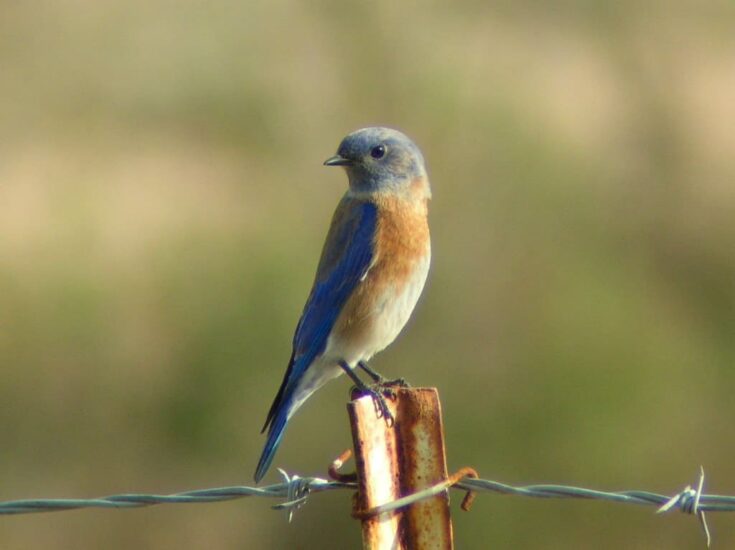
Learn how to attract bluebirds to your yard with these 11 easy tips. These tips are easy to implement for beginners and for experienced birders.
Materials
- Bluebird Nest Box
- Metal Pole
- Bluebird Feeder
- Heated Bird Bath
Instructions
- Create an Open Space for Bluebirds
- Put Up a Bluebird House (Nest Box)
- Add Some Low Perches to Your Yard
- Keep Crawling Predators at Bay
- Deter Non-Native Birds
- Put Up a Bluebird Feeder
- Install a Bird Bath
- Grow Plants that Attract Bluebirds
- Plant Trees that Attract Bluebirds
- Consider Keeping a Few Dead Trees
- Monitor Your Bluebird House Weekly

